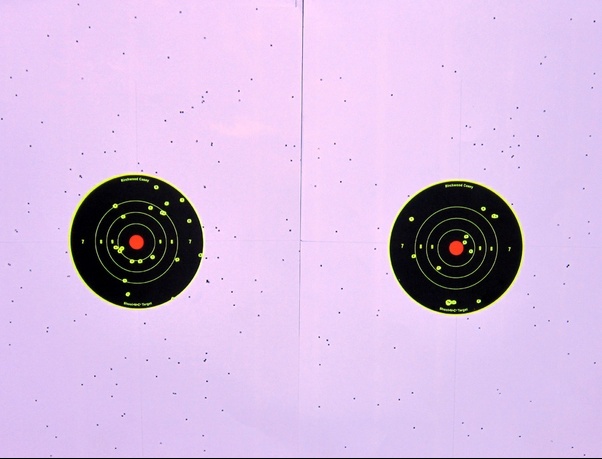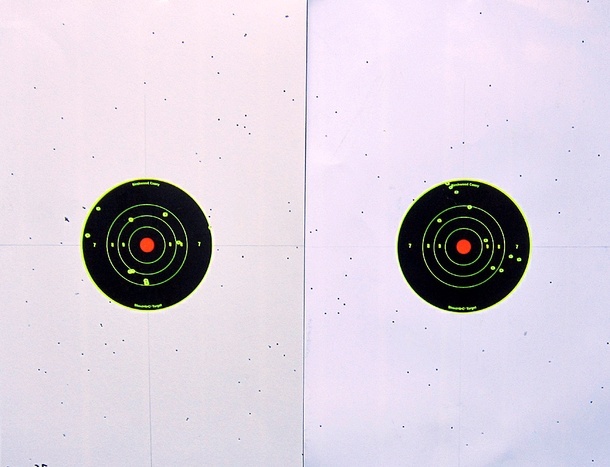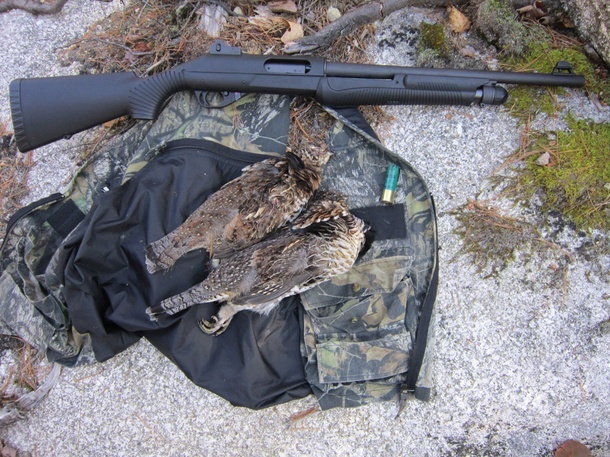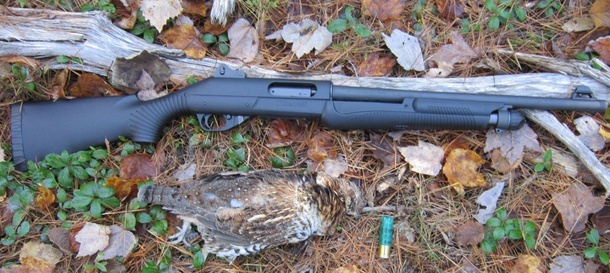During a recent stint as an employee at a local gun shop, one of the discussions that began amongst my coworkers during a rare slow day was how well a home defense optimized shotgun would work as an upland game gun. Would the short barrel and fixed choke typically characteristic of such guns be an asset or a handicap while in pursuit of ruffed grouse and snowshoe hare in the dense woods of rural Maine? Being the investigative type, I took it upon myself to find out.
Tactical = durability and utility
When the term “bird gun” is uttered, images of fine, walnut stocked side by side and over/under shotguns likely come to mind. Such scatterguns have been ubiquitous among small game hunters since the days when black powder, muzzle loading, double guns were the pinnacle of shotgun technology.
While I am undoubtedly fond of such elegant firearms and would jump at the chance to own a $10,000+ over/under, there are small game hunting scenarios in which the $400 home defense gun may be the better option. Consider, for instance the photo below of a section of eastern Maine woods.
In many respects, terms such as “woods” or “forest” are an incorrect label for such terrain and “impenetrable wall of flora” is far more honest terminology. A hunter does not walk through such terrain, he or she stumbles though it, more often than not ending a day afield covered in pine pitch and with an extensive collection of pucker brush scratches. Bringing a high dollar firearm with a fine wood stock into such an environment is akin to driving a Mercedes down a washed out dirt road at top speed.
By contrast, many of the features that allegedly make a shotgun “tactical” also make it ideal for hunting small game in thick brush. For example, the synthetic stocks of many home defense shotguns are incredibly durable and scratch resistant. Should a hunter trip and fall head first into a tangle of blackberry bushes and spruce saplings, the gun will be no worse for wear. Additionally, the short barrels found on tactical shotguns significantly reduce overall length thus improving maneuverability in the thick stuff.
The greatest potential limitation of a home defense shotgun in a small game hunting role has to do with the choke. Such guns usually come with a fixed choke (typically cylinder or improved cylinder) that allows a shot column to open up fairly rapidly. While at close range an open choke may improve a hunter’s chance of hitting a fast moving target, it may prove to be somewhat of a handicap in terrain that allows shots to be made at a variety of distances.
Pattern tests
Prior to fielding my own home defense shotgun – a 12-gauge Benelli Nova Tactical with an 18.5-inch barrel and a fixed improved cylinder choke – I took to the range to pattern test the gun with a small selection of birdshot loads. Tested loads included a 2-3/4-inch handload sporting 1-ounce of size 7.5 shot, the 2-3/4-inch Remington Express load with a 1-1/4-ounce payload of size 7.5 shot, and a 3-inch Federal Black Cloud load of 1-1/4 ounces of steel size BB shot.
The targets used in the pattern test consisted of 14×22-inch sheets of poster board with a 6-inch Shoot ‘N ‘C target at the center. The 6-inch central target was roughly the size of the kill zone of many upland game birds meaning that multiple pellet strikes within that circle would likely translate to a dead bird in the woods. The results of the pattern tests follow.
Test 1: Handloaded 1-ounce, size 7.5 shot and Remington 1-1/4-ounce Express size 7.5 shot at 10 yards
While a range of ten yards may seem unreasonably close, I have taken numerous ruffed grouse and more than a few rabbits at distances that were even closer. In fact, I have hunted areas where the woods are so thick that quarry more than 15 yards from a hunter is relatively safe from any common birdshot load.
As I expected, at ten yards the six-inch Shoot ‘n C targets were thoroughly peppered by both the 1-ounce and 1-1/4-ounce loads. At this distance, a direct hit on a bird or rabbit has the potential to result in an unacceptable amount of ruined meat.

Above: The ten yard patterns produced by the Remington Express load (left) and the 1-ounce handload (right).
Test 2: Handloaded 1-ounce, size 7.5 shot and Remington 1-1/4-ounce Express size 7.5 shot at 25 yards
At 25 yards, the pattern produced by my Nova became noticeably less dense. Even so, both tested loads planted multiple pellets in the 6-inch central target and would likely reliably take small game in the 20 to 25 yard range. Thirteen pellets from the 1-ounce handload landed in the kill zone and 20 pellets from the Remington Express load struck the central target.
Pellet coverage of the 14×22-inch poster board was fairly even for the Remington load while there were substantial gaps in the overall pattern generated by the 1-ounce handload. At longer distances, a heavier payload weight and higher pellet count seems to be an asset when working with an improved cylinder choke.

Above: The 25 yard patterns produced by the Remington Express load (left) and the 1-ounce handload (right).
Test 3: Handloaded 1-ounce, size 7.5 shot and Remington 1-1/4-ounce Express size 7.5 shot at 35 yards
While both the 1 ounce load and the 1-1/4-ounce Remington load put pellets on the central target at 35 yards, there were large gaps in the overall pattern large through which smaller game animals could easily slip. Ten pellets from the 1-ounce load landed in the central target and 9 from the Remington Express round landed in the center circle. While both loads are clearly capable of taking game at 35 yards, scoring a hit at that distance may require a certain degree of luck.

Above: The 35 yard patterns produced by the Remington Express load (left) and the 1-ounce handload (right).
Test 4: Federal Black Cloud, 1-1/4-ounce load of Steel size BB shot at 25 and 35 yards
The Federal Black Cloud waterfowl load incorporates a relatively recent innovation called the Flitecontrol wad. The Flitecontrol wad is a stiff, plastic shot cup that incorporates a series of integral air brakes designed to decelerate the wad in a way that allows a payload of shot to deploy in a more controlled manner than a conventional wad. The desired result is a tighter pattern regardless of the type of choke used.
I was interested to find out how the Flitecontrol loads would pattern out of my Nova, so I set targets at 25 and 35 yards and let fly with a couple of rounds. In spite of the low pellet count inherent to large shot sizes, the Black Cloud load fared quite well with 11 pellets striking the central target at 25 yards and six pellets striking the center at 35 yards. With a smaller shot size in a Flitecontrol wad, an open choked, short barreled shotgun could potentially be an effective medium-range turkey gun.

Above the 25 yard pattern (left) and 35 yard pattern (right) yielded by the Federal Flitecontrol load.
Hunting
With my range work complete, I set out into the nearby woods in hopes of finding out how the Nova would perform under actual hunting conditions. I was in luck during my outing as the ruffed grouse (known in northern New England as partridge) were out in droves. As usual, I did my fair share of missing but not due to any fault of the gun. In one instance I pulled the trigger just as a flying bird dodged into a stand of spruce saplings and in another instance I fired just as a running bird ducked into a bowl-like depression in the ground.
Later in the day, however, my reflexes and aim improved and I managed to bag two birds. One I took neatly at a range of approximately 20 yards as it wandered along the edge of a clear cut and another I knocked out of the air as it flew across the abandoned logging road I was walking.
As I expected, the Nova’s short overall length made maneuvering through the thickest stands of pines and poplar saplings as easy as such a task can be. Additionally, the gun’s ghost ring sights lined up quickly on walking and running birds, but were easy enough to ignore while attempting to lead flying birds.
While a short, open choked, home defense shotgun wouldn’t be my first choice for hunting fast and high flying waterfowl or pheasants in a corn field, when the woods are thick and brutal, a gun that’s short and rugged may just be what is required.

Above: Two delicious ruffed grouse were taken by the author using his Benelli Nova Tactical loaded with Remington Express, size 7.5 loads.
(566)





